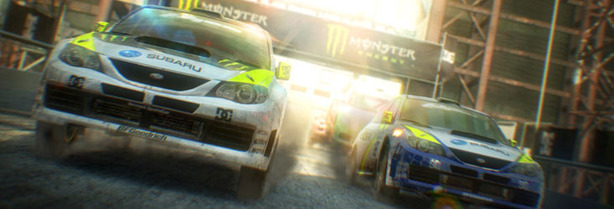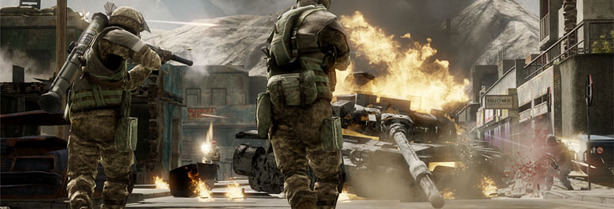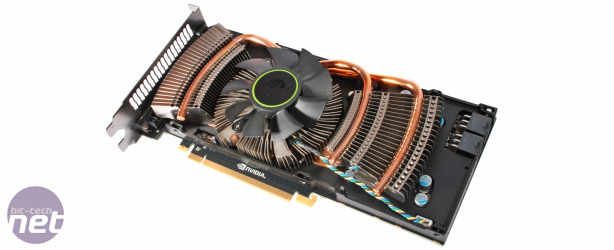
Performance Analysis
While the GTX 560 Ti 1GB’s increased frequency over the GTX 460 1GB is 20 per cent, that’s only part of the story. When you factor in the extra SM and its 48 stream processors, the increased double-precision abilities and the increased memory frequency it offers a potentially huge improvement in performance over the GTX 460 1GB , and this is clearly reflected in our testing.In Dirt 2 we found the GTX 560 Ti 1GB to outperform the Radeon HD 6970 2GB at resolutions below 2,560 x 1,600 (at 2,560 x 1,600 the 2GB of memory of the AMD card gives it the edge). While AMD cards have historically has comparably worse performance in Dirt 2, it’s impressive that a mid-range £200 card can outclass AMD’s fastest offering.
In comparison to Nvidia’s stable, the GTX 560 Ti 1GB couldn’t quite dethrone the GeForce GTX 480 1.5GB, but came remarkably close – pre-overclocked cards might even eclipse Nvidia’s previous-generation goliath. Of more interest is that the performance jump over the GTX 460 1GB was in enormous at every test setting: at 1,920 x 1,200 with 4x AA the GTX 560 Ti 1GB managed a minimum of 64fps rather than the 50fps minimum of the GTX 460 1GB – this is a 28 per cent improvement.

While Call of Duty: Black Ops is an easy game to run, it can still tell us plenty about a card’s performance. For example, the 1GB of memory of the GTX 560 Ti 1GB limited its performance at lower resolutions, although with a minimum of 65fps at 1,680 x 1,050 with 4x AA, it was the fastest of the 1GB cards. As we increased test resolution, the 1GB of memory was less of an issue: the GTX 560 Ti 1GB marginally outpaced the GTX 470 1.3GB at 1,920 x 1,200 and above, and was roughly 20 per cent faster than the GTX 460 1GB.
Competition with AMD varied, but typically the GTX 560 Ti 1GB found itself in an AMD sandwich, with the HD 6950 2GB faster and the HD 6870 1GB slower. At 1,920 x 1,200 the two AMD cards outpaced the GTX 560 Ti 1GB, even if that was only by 2fps in the case of the HD 6870 1GB. However, with 4x AA enabled, the GTX 560 1GB was faster than the HD 6870 1GB by 6fps or 12 per cent.
AMD says it will release two new drivers tomorrow (26 January 2011), a WHQL-certified Catalyst 11.1 driver and a Catalyst 11.1a hotfix driver. The latter claims an increase of around 20 per cent in Call of Duty: Black Ops when using MSAA with the Radeon HD 6800- and HD 6900-series among other improvements.
As far as performance is concerned, it was much the same story in Just Cause 2, with the GTX 560 Ti 1GB slightly faster than the HD 6870 1GB when 4x AA was enabled, but a bit slower when no AA was used. At 1,920 x 1,200 with no AA the GTX 560 Ti 1GB managed a minimum frame rate of 29fps and an average frame rate of 43fps, compared to the HD 6870 1GB’s minimum of 31fps and average of 43fps.
With 4x AA enabled at the same resolution, the GTX 560 Ti 1GB produced a minimum of 25fps compared to the HD 6870 1GB’s minimum of 24fps. The GTX 560 Ti 1GB is the better of the two cards for performance, as it gives you a little more speed when running the game with 4x AA.

Lastly, in Bad Company 2 the GTX 560 Ti 1GB again performed well, managing superior frame rates to those of the HD 6950 2GB throughout our testing. This may be down to the HD 6950's Caymen GPU still having infant drivers though (our numbers are based on the release driver). The GTX 560 Ti 1GB still impressed though, producing a minimum frame rate of 36fps at 1,920 x 1,200 with 4x AA – this is a 33 per cent improvement over the GTX 460 1GB. Only having 1GB of memory may have held the card back, however, as it was close to 20 per cent slower than the GTX 570 1.3GB.
We continued to be impressed when it came to heat output and power consumption. With our test system pulling 135W at idle and 285W, the GTX 560 Ti 1GB is roughly in the middle of the power consumption pack, with its higher clock speeds resulting in a 15W increase over the GTX 460 under load. Still, as the performance of the card is so much more than its predecessor, the 5 per cent increase in power consumption is hardly worth worrying about.
The reference cooler does a great job
The GTX 560 Ti 1GB’s reference cooler is what really impressed us though. Judging by the awesome temperatures we recorded of just 8°C above ambient at idle and 37°C above ambient at load, it appears Nvidia has heavily over-specced the cooler. What’s more, the fan’s speed barely jumped above 30 per cent even when the card was working hard, leaving the card inaudible over the rest of our test system’s fans. It’s almost a shame that many card manufacturers are choosing to use their own coolers rather than the reference one.

MSI MPG Velox 100R Chassis Review
October 14 2021 | 15:04









Want to comment? Please log in.